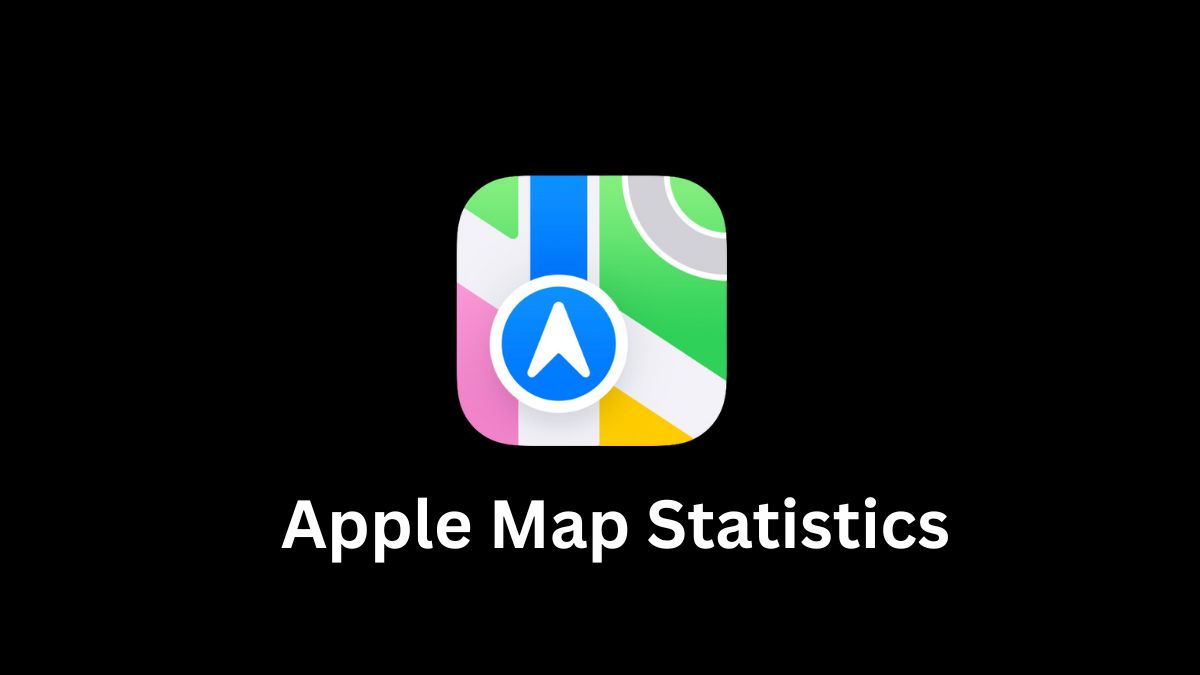Apple Map Statistics By Users, Features and Facts (2025)
Updated · Nov 02, 2025

Table of Contents
Introduction
Apple Map Statistics: Apple Maps has surprisingly become a major player in the mapping industry without making much noise. Initially, it was heavily criticized for its performance during the launch, but in 2025, Apple Maps is not only a smartphone app of the iPhone but also a platform that is being used by hundreds of millions.
Besides, it facilitates car navigation, provides transit information, lists merchants, creates developer experiences, and even assists Apple’s AI training. This article provides statistics on Apple Maps, including users, features, developers, and the service’s future.
Editor’s Choice
- Apple Maps is now the backbone of navigation, transit, business listings, and developer tools for a user base of hundreds of millions worldwide.
- The visibility that businesses get from being on Apple Maps is equivalent to having annual merchant transactions of tens to hundreds of millions of dollars.
- Ads in Apple Maps are predicted to launch in 2026, allowing local businesses to pay for premium positioning in search results on the map.
- The ad platform of Apple will utilise AI-targeted advertising to make recommendations feel natural and compliant with privacy standards.
- Sceptics point out that Map ads may harm Apple’s reputation as a privacy-centred business; however, analysts view it as a major opportunity for growth.
- In 2026, the number of active Apple Maps users is expected to grow to over 1 billion, supported by 1.3–1.5 billion active iPhone users.
General Apple Maps Statistics
- Global user base was reported around 500 million in 2024, making Apple Maps the second-largest consumer mapping app by audience.
- Independent estimates place today’s worldwide Apple Maps audience in a broad range from 200–950 million users, consistent with Apple’s statement that it has “hundreds of millions” of users.
- In the United States, usage was estimated at 82–110 million users in 2024, reflecting growth alongside the iPhone installed base.
- Share of mapping-app users attributable to Apple Maps has been estimated at 20–25% globally in 2024, with Google Maps retaining the lead.
- Among U.S. navigation app users, Apple Maps preference has been reported at roughly 25%, indicating a sizable but secondary position.
- The active iPhone installed base reached approximately 1.38 billion users globally as of October 2025, which defines the practical ceiling for Apple Maps’ direct addressable user base.
- Apple’s in-house “new map” data now covers 35 countries, reaching approximately 940 million people, 20.3% of the Earth’s land area, and 11.8% of the global population, thereby expanding the pool of users who experience Apple’s highest-fidelity maps.
- Apple’s street-level “Look Around” view covered approximately 82 areas as of May 2025, and the Company added Look Around to the web version of Apple Maps in December 2024, enhancing access for desktop users.
- Apple Maps supports transit and in-app payment cards in at least 22 cities or regions, including London, New York, Tokyo, Singapore, and the San Francisco Bay Area, which increases repeat usage among urban commuters.
- Apple’s default integration across iOS, iPadOS, macOS, watchOS, and visionOS continues to channel a large share of Apple device owners into Maps, sustaining a user base counted in the hundreds of millions.
How Many People Actually Use Apple Maps?
- Between 82 million to 110 million people in the United States used Apple Maps in 2024, based on updated estimates.
- Approximately 66% of iPhone users are believed to use Apple Maps on a regular basis.
- With an estimated 1.4 billion iPhones worldwide, this translates to approximately 918 million global Apple Maps users in 2024.
- Apple launched Apple Maps in 2012, and since then, the company has not officially disclosed user numbers.
- Many businesses gain visibility from being listed on Apple Maps, even though some Android users may overlook it.
- A 2023 estimate by MomentFeed’s Eoghan Goeghegan suggested 68 million adults in the U.S. used Apple Maps monthly.
- Analyst Horace Dediu later suggested that there are at least 1 billion Apple Maps users globally.
- CarPlay integration has expanded Apple Maps use, as over 80% of new cars in the U.S. support it.
- About 23% of new car buyers consider CarPlay a “must-have” feature.
- With roughly 4 million new cars sold in early 2024, this implies over 700,000 new vehicle owners are using CarPlay this year.
- The U.S. population is around 332 million, with about 256 million adults (77%).
- Approximately 85% of U.S. adults own a smartphone, equal to 217 million people.
- As of 2021, approximately 52.4% of U.S. smartphone users owned an iPhone, totalling 114 million iPhone users.
- Of those, an estimated 71 to 100 million adults use Apple Maps.
- Competing navigation apps include Waze (around 15 million U.S. iPhone users) and others like Here or MapQuest (about 5 million users).
- Assuming all adult iPhone users use navigation apps, Apple Maps and Google Maps together serve roughly 94 million users.
- In 2015, Apple stated Apple Maps was used 3 times more than Google Maps among iPhone users.
- With improvements in performance and reliability, Apple Maps usage is likely even higher today, possibly 4 times more than Google Maps.
- Analysts believe the minimum number of adult Apple Maps users in the U.S. is 75 million, and the maximum could reach 100 million.
- The actual figure remains undisclosed by Apple, but estimates confirm Apple Maps is one of the most used navigation apps globally.
Apple’s Ad Market Rise
- Apple is quietly building a massive advertising empire that is more powerful than ever and growing faster than most people realise.
- Although the giant rarely shares its ad strategy with the public, it has been gradually increasing its share in the digital advertising space, especially after introducing its iOS privacy update, which curtailed third-party tracking —a major factor in its growth.
- Reportedly, the tech giant plans to increase its workforce for digital ads, and this time, it will be twice as large.
- The company’s effort to “redefine advertising” for a privacy-first world is already impressive; its global ads business generated almost US$3.7 billion in revenue during 2021.
- By the last quarter, sales from its Services division, which comprises ads, App Store, Apple Music, iCloud, Apple TV+, and Apple Pay, among others, soared to US$19.6 billion, making up almost 25% of Apple’s quarterly income.
- According to industry analysts, Apple’s advertising revenue is expected to soar to US$30 billion per annum by 2026, thus positioning it as one of the company’s largest business segments.
- Although the figure is still less than Amazon’s equal revenue of US$30 billion and is far from Google’s revenue of US$200 billion from ads, Apple’s ad growth is very big. Thanks to its integrated ecosystem along with mastery over user data, it is developing to be the most profitable and sustainable part of the growing services portfolio of Apple.
Apple Maps Vs Google Maps
Global Users
- Google Maps: Reported to have surpassed 2 billion monthly users in October 2024, according to Alphabet’s earnings commentary.
- Apple Maps: Apple does not publish user numbers. A leading local-SEO analysis estimated 82–110 million users in the U.S. in 2024 and, using an assumed adoption share among iPhone users, extrapolated a rough global estimate based on the active iPhone base. Treat this as indicative rather than official.
Geographic Reach
- Google Maps: Coverage in 250+ countries and territories and Places data for 250M+ businesses and points of interest.
- Apple Maps: Available in 200+ regions globally; Look Around street-level imagery live across dozens of countries with ongoing 2024–2025 expansions.
Data Scale and Imagery
- Google Maps: 250M+ places; 280B+ Street View images in 100+ countries; long-standing reference to 10M+ miles of Street View roads.
- Apple Maps: Look Around coverage expanded across Europe, North America, and parts of APAC and LatAm through 2025; Apple continuously collects new imagery.
Developer Ecosystem
- Google Maps: Used by 5M+ apps and websites via Google Maps Platform; widely deployed across enterprise and consumer applications.
- Apple Maps: MapKit and MapKit JS power third-party apps on Apple platforms; Apple does not disclose comparable app counts.
Monetization and Revenue Context
- Google Maps: Revenue is not broken out separately by Alphabet. Monetization occurs via advertising in Maps and usage-based fees from Google Maps Platform; analysts describe Maps as a multi-billion-dollar business, while Alphabet reports revenue at broader segment levels.
- Apple Maps: No direct consumer pricing; Maps supports Apple’s ecosystem value and Services stickiness. Apple does not disclose Maps revenue as a standalone line.
Core Features
- Google Maps: Turn-by-turn navigation, public transit in most major metros, Live View AR navigation, multi-stop routing, EV charging availability, indoor maps, and robust local business profiles and reviews.
- Apple Maps: Turn-by-turn navigation, offline maps (iOS 17+), Look Around street-level view, cycling and EV routing in supported regions, transit integration with Wallet in many markets, and detailed 3D city experiences; availability varies by country.
Local Search and Commerce
- Google Maps: Hosts business listings at very large scale (industry tallies cite 150M–200M+ businesses and places), and benefits from high local-intent search share on Google. These factors reinforce discovery and ad demand.
- Apple Maps: Business placecards, ratings, and booking integrations are available in many markets, but Apple does not provide aggregate business-count disclosures.
Privacy Posture
- Google Maps: Offers opt-in Location History and controls; data use under Alphabet privacy policies, with advertising as a core business model.
- Apple Maps: Emphasizes on-device processing and limited data retention; Apple positions Maps privacy as a product differentiator in official materials.
Platform Advantage
- Google Maps: Very large cross-platform footprint on Android, iOS, and web, combined with extensive developer adoption and ad infrastructure. The 2B+ monthly user scale and 250M+ places graph are major network assets.
- Apple Maps: Deep integration with iOS, watchOS, CarPlay, and Apple services supports consistent performance for Apple users; feature coverage continues to expand internationally.
Bottom Line
- Reach and data density: Google Maps leads on global user scale and third-party adoption, underpinned by 2B+ monthly users and a 250M+ places database.
- Ecosystem integration and privacy: Apple Maps is optimized for Apple devices and markets itself on privacy and seamless integration; usage levels are significant within the iOS base but are not officially reported.
Apple Maps Widens Reach with New Features
- The period from 2023 to 2025 was crucial for Apple Maps in terms of enhancing its global mapping capabilities.
- The Look Around feature, Apple’s take on street-level imagery, is now available in approximately 80 to 90 regions worldwide, allowing users to view cities and streets in a highly realistic 3D format from both mobile and web platforms.
- Apple has a large mapping fleet, consisting of specialised vehicles and teams of backpackers equipped with high-tech cameras and sensors.
- Those teams are constantly collecting 3D imagery, maps of the roads and traffic data in hundreds of cities worldwide, thus keeping Apple Maps accurate and updated.
- Moreover, in addition to its accuracy, Apple Maps has introduced new transit and navigation tools, offering real-time updates on public transportation, cycling and walking directions, ride-sharing services, and electric car charging route planning.
- These features not only make Apple Maps visually superior but also a more trustworthy and versatile navigation tool for people worldwide.
Apple Maps, Growth and Integration
- Connecting developers, users, and businesses inside the Apple ecosystem is largely done by Apple Maps.
- Using MapKit and the Maps Server API, app developers can very easily add maps, navigation, and local search features to their apps, be it for ride-hailing and delivery platforms or for travel and retail services. This integration spurs user engagement and helps with in-app commerce.
- The Apple App Store ecosystem generated approximately US$277 billion in total billings and sales in 2024, indicating the indispensable role played by mapping and local discovery in the digital business world.
- While Apple has not yet reached Google’s level of monetising Maps, it still exerts a great commercial impact by indirectly leading users to the nearest restaurants, shops, and booking options.
- So basically, every time a user discovers a business via Apple Maps, there is a possibility of direct sales or in-app purchases; this flow of money is estimated to be worth tens to hundreds of millions of dollars a year.
- Eventually, the new features for merchants, together with local listings that Apple is incorporating into Maps, will further increase the economic impact of Maps on developers and businesses.
Apple’s Services, Maps Ads Future
- The company’s shift from hardware production to services has completely changed the way it does business.
- Apple’s global base of over 2.3 billion active devices and more than one billion subscribers to paid services generates around US$100 billion annually from its services alone.
- The company’s ranking as a mobile phone supplier, focusing on selling iPhones, has shifted to a hybrid model powered by recurring revenue, encompassing streaming and cloud services, digital payments, and advertising.
- Apple is not planning to venture into this domain but rather expects to have a wider impact on the market via its core maps business, according to Bloomberg.
- Beginning in 2026 or possibly even earlier, the company intends to start charging for placements in the Maps app.
- This would give restaurants, retailers, and other local businesses the option of running paid promotions to increase their visibility when users search for nearby places.
- The new system would resemble a lot to App Store Search Ads, as advertisers would be bidding for the best positions in the search results of maps.
- But Apple’s version is said to provide a more subtle and controlled experience by employing AI-driven targeting to make the sponsored results feel like they are part of the normal search, and they are very relevant to the user.
- Apple critics contend that its ecosystem is increasingly filled with various types of content, often promotional in nature — Apple Music, AppleCare+, and others, to mention just a few.
- The concern that introducing ads in main apps, such as Maps, could raise questions about the brand’s image of being customer-centric and simple over the years is voiced by some.
- On the other hand, Apple’s global service sector, comprising Apple Music, Apple TV+, Apple Pay, App Store, and iCloud, is continually expanding.
- According to Statista, the segment grew to US$27.4 billion in the third quarter of 2025, which is more than double the figure five years earlier; thus, it means an increase rate of 108%.
- As the cycles of replacing iPhones become longer, the company relies heavily on recurring income from subscriptions, in-app purchases, and advertising.
Future Outlook
- By the end of 2026, Apple Maps is likely to remain a significant player due to the continued global adoption of iPhones.
- Having the number of active iPhone users globally predicted to stay around 1.3 to 1.5 billion, Apple Maps could still count on more than 1 billion active users.
- The quality of the data that Apple receives from the APing is good enough to warrant a valuation of tens to hundreds of millions of dollars.
- This is the area where Apple Maps is likely to play a significant role in AI, particularly in navigation, visual recognition, and augmented reality applications.
- In terms of the market, Apple Maps is expected to gain a slight increase in market share, particularly in areas where iOS is the most widely used system.
- A couple of years down the road, analysts expect to see an increase of 2% to 10% in Apple’s market share due to the introduction of new features, improved integration, and the provision of discovery and vending services for local businesses.
Conclusion
Apple Map Statistics: By 2025, Apple Maps is not the only navigation tool but the powerful global platform that includes many more services. With over a billion potential users, it links up mappers, commerce, and advertising through its modern features, while it also serves the back office of people’s interactions through its advanced customer and developer support. Apple’s unceasing investment in AI, location-based services, and paid placements indicate good prospects for mapping ecology.
Apple Maps will be boosting the engagement and revenue of Apple’s services empire which has already surpassed US$100 billion. Looking to the future, Apple Maps is poised to become not only a navigation tool but also a key item in the digital growth strategy of the entire company by 2026.
FAQ.
Apple Maps will have already a user base of over 1 billion worldwide in 2026. The total active users might reach 1 billion in 2026 as per the projections. Main support for this extensive user base comes from Apple’s ecosystem of 1.3-1.5 billion iPhone users.
Apple will let the paid ads in Apple Maps by 2026 and this is the start of the local advertisement of businesses like restaurants, and shops, etc. The model will be quite similar to App Store Search Ads, where advertisers will bid for top spots. The critics are anxious that this could compromise Apple’s minimalist experience but the analysts see that this is a giant step toward the goal of US$100 billion services empire.
Apple Maps is an essential service for the Apple ecosystem that links developers, businesses, and users through location-based tools and commerce. In 2024 the App Store ecosystem credit for US$277 billion in total revenue, a portion of which was influenced by local search and discovery within apps that rely on Apple Maps.
Apple’s advertising division has been growing fast, with revenues of US$3.7 billion recorded in 2021 and an annual estimate of US$4 billion for 2022. The growth rate is so high that some experts are saying that by 2026 it will be worth US$30 billion, and this is all due to the fact that they are investing in new ad channels like Apple Maps. The Company’s Services sector consisting of advertising, App Store, Apple Pay, and iCloud combined, earned US$19.6 billion in just one quarter, which accounts for 25% of Apple’s total revenue.
Apple Maps is expected to be a significant factor in both navigation and AI by 2026 and beyond. Apart from the huge user base that is estimated to be over 1 billion, Apple Maps will also provide data which will be beneficial in training AI for self-driving technology, visual recognition, and augmented reality (AR) experiences.

Maitrayee Dey has a background in Electrical Engineering and has worked in various technical roles before transitioning to writing. Specializing in technology and Artificial Intelligence, she has served as an Academic Research Analyst and Freelance Writer, particularly focusing on education and healthcare in Australia. Maitrayee's lifelong passions for writing and painting led her to pursue a full-time writing career. She is also the creator of a cooking YouTube channel, where she shares her culinary adventures. At Smartphone Thoughts, Maitrayee brings her expertise in technology to provide in-depth smartphone reviews and app-related statistics, making complex topics easy to understand for all readers.










